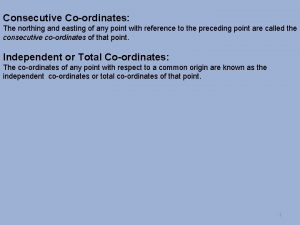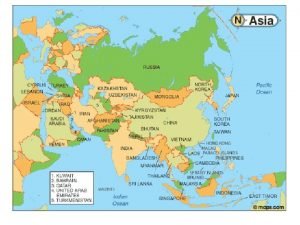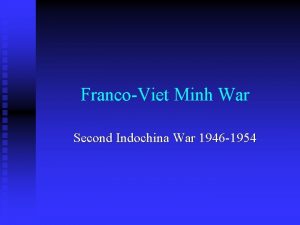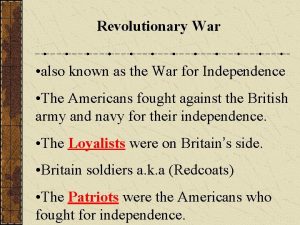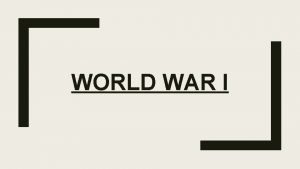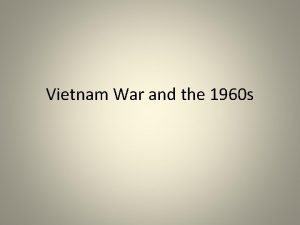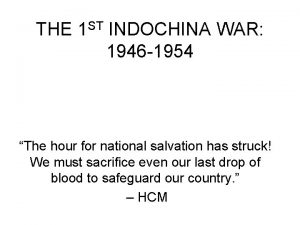Also known as second Indochina war known in










- Slides: 10


ü Also known as second Indochina war. ü known in Vietnam as the Resistance War Against America. ü Occurred in Vietnam, Laos, and Cambodia. ü Fought from 1 November 1955 to on 30 April 1975. ü Officially fought between North Vietnam and the government of South Vietnam. ü North Vietnamese army was supported by the Soviet Union, China and other communist allies. ü South Vietnamese army was supported by the United States, South Korea, Australia, Thailand other anti-communist allies. ü considered a Cold War-era proxy war.

ü War exacted a huge human cost in terms of fatalities. ü Estimates of the number of Vietnamese soldiers and civilians killed vary from 966, 000 to 3. 8 million. ü Some 240, 000 – 300, 000, Cambodians, 20, 000 – 62, 000 Laotians died. ü 58, 220 U. S. service members also died in the conflict, and a further 1, 626 remain missing in action. ü The capture of Saigon by the North Vietnamese Army in April 1975 marked the end of the war, and North and South Vietnam were reunified the following year.

The media gathers its information from various sources: Overt Sources • Press briefings. • Press releases/handouts. • Supervised visit/tour of battle area. Covert Sources • Own contacts. • Electronic Eaves dropping. • Clandestine visits to battle area.

ü role of the media in the Vietnam War is a subject of continuing controversy. ü media played a large role in the U. S. defeat. ü media’s tendency toward negative reporting helped to undermine support for the war in the United States. ü uncensored coverage provided valuable information to the enemy in Vietnam. ü played a vital role in dramatic shifts of opinion. ü The horrors of war entered the living rooms of Americans for the first time during the Vietnam War. ü Media at that time brought brutality of war to American homes thus affecting the mindset of American people about the American government.

ü Vietnam became a subject of large-scale news coverage in the United States. ü By 1968, at the height of the war, there were about 600 accredited journalists of all nationalities in Vietnam, reporting for U. S. wire services, radio and television networks, and the major newspaper chains and news magazines. ü proximity to the battlefield carried obvious risks, and more than 60 journalists were killed during the war. ü The Vietnam conflict is often referred to as the “first television war. ” ü Film from Vietnam was flown to Tokyo for quick developing and editing and then flown on to the United States.

§ On television screens and magazine pages around the world, photographs told a story of a fight that only got more confusing, more devastating, as it went on. § Think of the War in Vietnam and the image in your mind is likely one that was first captured on film, and then in the public imagination. § These pictures sometimes showed brutality of the war and also sometime dark side of the war.

1. ü the little nine year old Vietnamese girl running naked from the napalm strike near Trang Bang on 8 June 1972

2. ü The picture of a Huey helicopter evacuating people from the top of what was billed as being the U. S. Embassy in Saigon during the last week of April 1975 during the fall of Saigon

3. ü Soldier, seen from the back, facing a Vietnamese woman hugging a baby, with a half-naked boy by her side
 27 miles per gallon into kilometers per liter
27 miles per gallon into kilometers per liter Which is the main circuit board in the computer
Which is the main circuit board in the computer Audit approach
Audit approach What is security survey
What is security survey Which of the following is an absorption type dynamometer?
Which of the following is an absorption type dynamometer? Consecutive coordinates is also known as
Consecutive coordinates is also known as Exhaust air throttling
Exhaust air throttling Lami theorem
Lami theorem Stuffing bit
Stuffing bit Macbeth jeopardy
Macbeth jeopardy Market channel definition
Market channel definition





